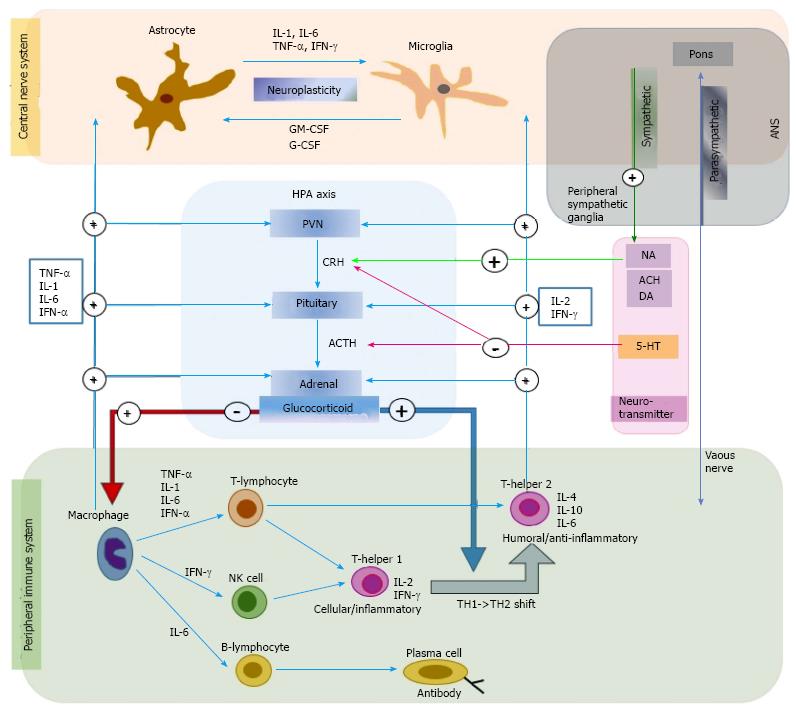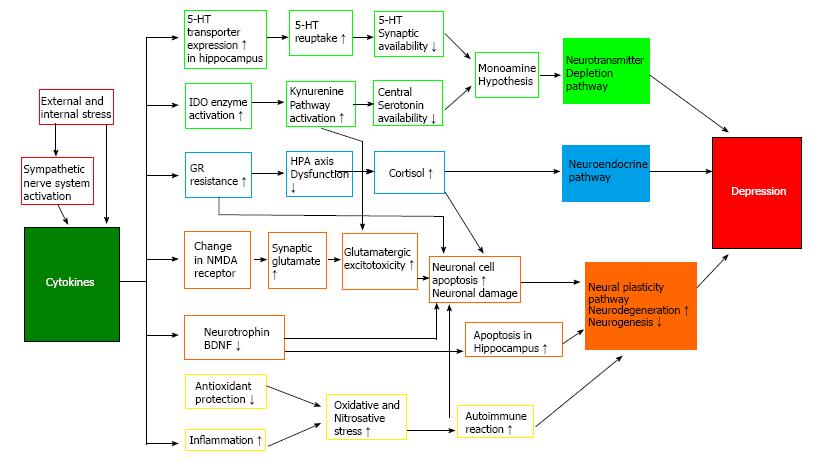Copyright
©The Author(s) 2016.
World J Psychiatr. Sep 22, 2016; 6(3): 283-293
Published online Sep 22, 2016. doi: 10.5498/wjp.v6.i3.283
Published online Sep 22, 2016. doi: 10.5498/wjp.v6.i3.283
Figure 1 The role of cytokine network in depression in connection with immune system, hypothalamic-pituitary-adrenal axis, neurotransmitter, and autonomic nerve system.
The figure shows communication between peripheral and central cytokine system. Early innate proinflammatory cytokines released by macrophage (TNF-α, IL-1, IL-6 and INF-α), and late acquired T cell cytokines (IL-2 and INF-γ) stimulate glucocorticoid secretion by acting at all three levels of the HPA axis. Glucocorticoids are negatively feedback on the peripheral immune system to suppress the production of proinflammatory cytokines. Glucocorticoids also play an important role in causing a shift from cellular (T-helper 1) to humoral (T-helper 2) immune responses. The central cytokines are usually secreted from the astrocyte or microglia. Central cytokines (IL-1, IL-6, TNF-α, and IFN-γ) are considered to be involved in neuroplasticity in brain. The neurotransmitters (NA, ACH, and 5-HT) regulate the peripheral cytokines by changing the cortisol concentration level. The Ach, DA, and NA promote the secretion of the CRH in hypothalamus, and 5-HT inhibits the secretion of the CRH in hypothalamus and the ACTH in pituitary. The ANS also regulates the peripheral cytokine production. The parasympathetic nerve directly reaches the immune system while the sympathetic nerve affects the immune system through the NA secretion from the peripheral sympathetic ganglia. 5-HT: Serotonin; ACH: Acetylcholine; ACTH: Adrenocorticotropic hormone; ANS: Autonomic nerve system; CRH: Corticotropin-releasing factor; DA: Dopamine; HPA: Hypothalamic-pituitary-adrenal; NA: Noradrenalin; PVN: Paraventricular nucleus of the hypothalamus; TH: Helper T cell; IL: Interleukins; TNF: Tumor necrosis factor; IFN: Interferons.
Figure 2 Schematic representation of neuroinflammatory pathways in the pathogenesis of depression.
Cytokine production is initially activated by stress and sympathetic nerve system activation. In turn, cytokines have an important role by acting via neurotransmitter depletion pathway, neuroendocrine pathway, and neural plasticity pathway. There are multiple interactions between these pathways suggesting existence of a complex model for pathogenesis of depression. 5-HT: Serotonin; BDNF: Brain derived neurotrophic factor; GR: Glucocorticoid receptor; HPA: Hypothalamic-pituitary-adrenal; IDO: Indoleamine-2,3-dioxygenase; NMDA: N-methyl-D-aspartate.
- Citation: Jeon SW, Kim YK. Neuroinflammation and cytokine abnormality in major depression: Cause or consequence in that illness? World J Psychiatr 2016; 6(3): 283-293
- URL: https://www.wjgnet.com/2220-3206/full/v6/i3/283.htm
- DOI: https://dx.doi.org/10.5498/wjp.v6.i3.283










